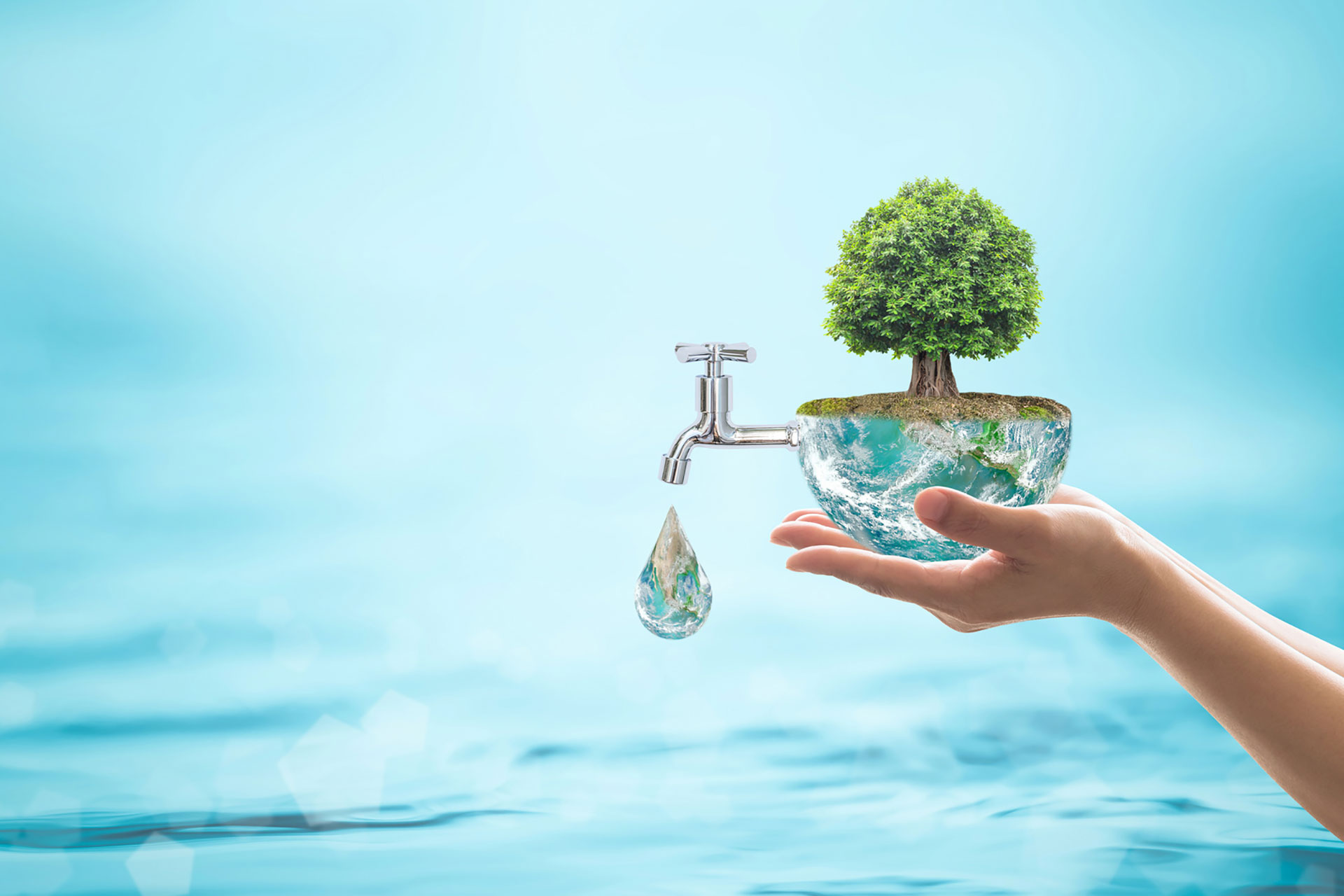Water resources and the use of water, which are among the most significant elements of today’s discussions on environment, are of vital importance for the future of humankind. The most important reason for these discussions is the fact that water, without doubt, has an irreplaceable vital function. Even though 71% of the earth’s surface is covered by water, 97.5% of water resources is salt water. The rate of portable water, in other words, fresh water is only 2.5%. This fact indicates that in near future more severe problems will be faced in addition to existing issues regarding the access to and use of water resources, if no measures are taken in a world with a population of more than 7 billion. Humankind is going through a process, in which they must evaluate, preserve and manage many alternatives more effectively such as the fight against drought, saving water, searching for new water resources, desalination of salt water.
Water, which is of strategic and vital importance, keeps decreasing together with global warming. Because of the lack of precipitation due to global warming, the high evaporation and fast consumption rate, freshwater resources are running short at a fast pace. While one third of countries do not have water or have a problem in accessing it, 20 percent of the world population cannot find fresh water. On the other hand, seas, lakes, rivers and groundwaters continue being contaminated by industrialization. According to estimates for 2025, more than 3 billion people will be exposed to water stress and approximately 15 countries will move from water stress to water shortage.
Water as the Basis for Sustainable Development
Conferences conducted and reports presented by international institutions reveal the dangers facing water resources and show in line with the water-shortage approach, within the framework of water contamination and the negative impacts of it, that water management is a global problem. For example, the 2012 UN Conference (RIO+20) report concerning sustainable development, indicates that ‘water is the basis for sustainable development’. However, development and economic growth turn water safety for humans and nature into a problem by creating pressure on resources. Ambiguities concerning the necessary amount of water to meet the consumption demand and protect the ecosystems remain. These ambiguities are also increasing due to the impact of climate change.

Hidden Water Consumption or Virtual Water
Every year, shortage of water affects 2.7 billion people for at least one month. Tap water running at homes is only a part of the water we use. Water is used at most in the production and processing phase of goods and services we consume. In other words, it takes 23 times of domestic water use to produce food and ware. Apart from the water we directly use, the amount of water used for a product during a whole life circle is called “virtual water”. For example, the production of one kilogram of beef takes approximately 15,000 liters of water. As for a 200 g pack of potato chips, 185 liters of water is used. For a pair of leather shoes 8,000 liters of water is used, whereas it takes 10 liters of water to produce a single sheet of A4-paper.
Most Water is used in Agriculture
If industrialization is considered together with the sociocultural structure of the society and the environment, then it is realized that agriculture accounts for 70% of all water consumption, whereas 19% for industry and 11% for domestic use. Developed countries consume 10 times more water than developing countries and 25 times more than water-stressed countries. “Kentler kuruldu kurulalı İlk kez,These data show that the water crisis will be more widespread in the following years due to the impact of global warming. In times of climate change, the fight against drought and water crisis obliges us to depart from the old understanding, which primarily regards huge interferences with nature as a great success, and not to repeat the same mistakes. The solution lies in turning ourselves towards the rules of ecology and an understanding of rehabilitation that conforms with nature.

Cape Town “Day Zero”
Human-induced climate change has also an impact on precipitation and causes drought. The most recent instance is the drought in Cape Town, the capital city of South Africa, that has given rise to a water crisis in the country in the past few years. According to the report published by the Working Group of IPCC on human-induced climate change and its impact on precipitation, human-induced climate change has more than tripled the probability of drought in Cape Town. The drought, which continues for three years, caused severe water shortage in South Africa. The reserves of Cape Town declined to very critical levels. Both the government and residents started taking measures. In the city, which is in danger of running out of water, the water use of residents were firstly limited to 50 liters per day, then it was announced that this amount would be reduced to 25 liters by implementing “Day Zero”. Most people stopped having a shower every day and saved the water they used for showering in big tubs to use them later for cleaning. This problem in Cape Town has also become a subject of documentaries. Seeking an answer for the question “Can you spend a day by using only 25 liters of water?”, the documentary ‘25 Litre’ also draws attention to water shortage, which is predicted to affect the whole world in the future.
New Method to Desalinate Seawater
It has been observed that the world population tripled in the last century, but the use of water increased seven times. The rise of water consumption has also made the search for new water resources to a current issue. Desalination of seawater is one of these. Russian scientists working on this issue (National Nuclear Research University MEPhI) have developed a technology to help desalinate seawater faster than existing technologies and increase the efficiency of solar generators. Compared to water boiling, this technology can produce more vapor by boiling with light-absorbing nanoparticles. It is stated that with this new method, it will be possible to desalinate and disinfect seawater or waste water faster by only using concentrated sunlight at first.
Only 1 percent of the total 1,4 billion km³ water reserve on the earth is usable fresh water. Taking into consideration that almost 25 percent of the freshwater reserves can be lost due to global warming, humankind needs to review their water and environmental policies. Saving water, efficient use of water resources and raising awareness in societies are among the upcoming big tests to be taken by us…
References
AA (2019), ‘Türkiye’de Kişi Başı 190 Litre Su Tüketiliyor’
https://www.aa.com.tr/tr/turkiye/turkiyede-kisi-basi-190-litre-su-tuketiliyor/1454848
BM (2015), Sürdürülebilir Bir Dünya İçin Su, Birleşmiş Milletler Dünya Su Gelişim Raporu, 8,9.
DENIZ HABER AJANSI (2020), Deniz Suyu, Güneş Işığı Ile Tuzdan Arındırılabilecek
https://www.denizhaber.net/deniz-suyu-gunes-isigi-ile-tuzdan-arindirilabilecek-haber-98477.htm
GEZER Aslı, ERDEM Ayça (2018), Su Stresi, Su Kıtlığı ve Su Tasarrufu Hakkında Halkın Farkındalığının Belirlenmesi: Akdeniz Üniversitesi Örnek Çalışması, Artvin Çoruh Üniversitesi, Doğal Afetler ve Çevre Dergisi, Cilt:4 ∙ Sayı:2, 113-114.
HaberTürk (2019), National Geographic, Suyun Hayatımızdaki Önemine Dikkat Çekmek Için Yarının Suyu Projesi Kapsamında, “25 Litre” Adlı Bir Belgesel Çekti
https://www.haberturk.com/temiz-su-icin-25-litre-belgeseli-2436400
KURNAZ Levent, ŞAHİN Ümit (2014), İklim Değişikliği ve Kuraklık, Sabancı Üniversitesi İstanbul Politikalar Merkezi,16-23.
T.C. KALKINMA BAKANLIĞI (2014), Su Kaynakları Yönetimi ve Güvenliği, Özel İhtisas Komisyonu Raporu, Ankara, 1-6.
T24 (2018), Cape Town Sakinlerinin Su Tüketimine 50 Litre Sınırı Getirildi
https://t24.com.tr/haber/cape-town-sakinlerinin-su-tuketimine-50-litre-siniri-getirildi,545234
UĞURDAĞ Sinem (2019), Su Ayak İzimizin Farkına Varalım, Buğday Derneği, https://www.bugday.org/blog/su-ayak-izimizin-farkina-varalim/
WWF-Türkiye (2020), Su Döngüsünü İyileştirmek İçin: Yağmur Suyu Hasadı, 6,7.
YILMAZ Ayşe (2015), Küresel Isınmanın Dünya Su Rezervleri Üzerindeki Etkileri, Kent Kültürü ve Yönetimi Hakemli Elektronik Dergi, Cilt:8 Sayı: 2, 63-69.


